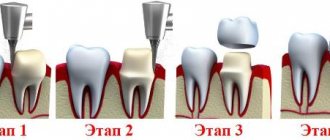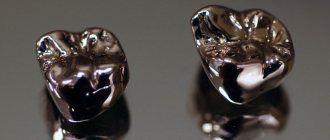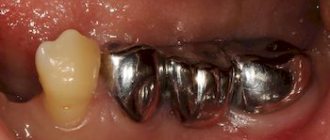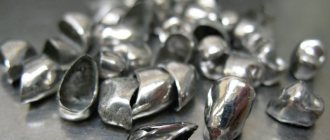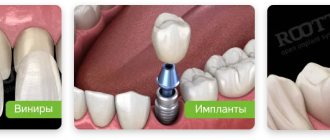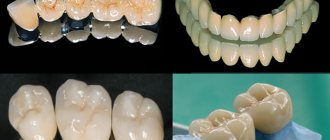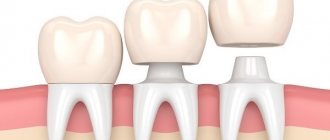10518
A crown is a single permanent prosthesis that acts as a kind of cap on a damaged tooth, and can serve its owner for 15 years, subject to the installation regulations and rules of care during use.
However, if an unpleasant odor or painful sensations appear, it becomes necessary to dismantle the structure.
Removing a crown from a tooth is an unpleasant procedure, but in some cases it is the only way to eliminate the problem.
Indications
Prosthetics with crowns is a labor-intensive and time-consuming procedure, sometimes accompanied by pain and discomfort.
To remove the structure, the specialist must have compelling reasons, otherwise he will do everything possible to avoid extreme measures.
A fixed orthopedic device is subject to disposal in the following cases:
- Incorrect installation of the product .
The crown may lose stability due to mistakes made by the doctor during its installation, the use of low-quality dental cement, or the destruction of the filling connecting material at the junction points. It is easy to recognize such a problem, since the dental unit begins to loosen and cause discomfort during eating and conversation. - Formation of a cyst on a tooth under a denture . This pathology rarely occurs as a result of various provocateurs. After removing the structure, the specialist removes the abnormal cavity and carries out full treatment.
- Destruction of an adjacent tooth . Another indication for re-prosthetics. In such a situation, the doctor advises installing a bridge instead of two adjacent prostheses.
- Bad odor and toothache. In this case, there is an urgent need for treatment hidden under the structure of the teeth.
Signs of the inflammatory process can develop against the background of the action of infectious agents, progression of pulpitis or secondary caries. In less severe situations, the doctor does not remove the prosthesis, but drills a small hole in it through which he carries out therapeutic treatment.After all the necessary manipulations have been carried out, the hole is filled with cement. Such work significantly reduces the service life of the structure.
- Inflammatory processes in the periodental tissues and gum disease .
Disease processes in periodontal tissues can develop due to various factors - inflammation, trauma, poor-quality manufacturing and fixation of the product. The structure puts strong pressure on the free gum, rubs, and a serious pathology begins to develop that cannot be treated independently. The product must be removed with subsequent treatment of soft structures. - Repeated prosthetics at the request of the patient . The patient can independently decide to replace the device with a more expensive and high-quality product.
- Broken prosthesis . The appearance of cracks and chips on the surface of the crown is also a reason for its dismantling.
Features of the production of Noritake metal-ceramic crowns, their advantages and disadvantages.
Come here if you are interested in the characteristics of Duceram metal-ceramic crowns.
At this address https://www.vash-dentist.ru/protezirovanie/nesemnyie-p/koronki-np/metallokeramicheskih-vita.html there is a detailed description of the Vita crown.
Treatment without removing the structure
In practice, it is rarely possible to reuse a structure after its removal and tooth treatment. Most often, you have to re-create the prosthesis, which means additional expenses and days of waiting. But in some situations you can do without removing the crown at all. For example, a doctor can perform root canal treatment by first forming a small hole directly in the prosthesis or, for example, through an incision in the gum if a cyst needs to be removed. If manipulations are performed through a slot in artificial material, upon completion of the procedure, the doctor will carefully close the defect with filling material.
In some cases, treatment can be carried out without removing the crowns
You need to understand that such treatment can only be done by an experienced, highly qualified professional. It is also important that the pathological process is at an early stage of its development. While the problem has not yet reached a large scale, there remains a chance to eliminate it with minimal losses. And in order to be able to detect this problem in time, it is necessary to regularly visit the dentist’s office once every six months - for prevention and professional cleaning of plaque and deposits.
1Borovsky E.V. Therapeutic dentistry, 2003.
Techniques
In dental practice, various methods of removing crowns are used. The choice depends on the existing clinical picture and the target direction of dismantling.
The decision on the method used is made by the patient, taking into account his financial capabilities and the time he can devote to it. Let's consider the existing options in detail.
Kopp apparatus
A crown remover is a dental instrument that greatly simplifies the work of a specialist and gives him the opportunity to painlessly remove the prosthesis without resorting to its destruction.
The device looks like a special hook , the operation of which is started by a button located on the holder. The procedure begins with breaking the cement under the structure using a drill. Next, using special forceps and hooks, the crown is picked up and picked out.
The method is considered a low-traumatic and painless procedure. However, it has one significant drawback - in some cases the device leaves scratches on the ceramic coating of the product , as a result it will require restoration.
Coronaflex device
The device operates on the basis of compressed air , which destroys cement. At the beginning of the procedure, the device should be operated with minimal impact force to avoid damage to the tooth.
The crown in the chewing area is removed using forceps. The device is installed so that its body is under the arc of the forceps.
special brackets as auxiliary tools , which are fixed on the crown using an adhesive system. Then the procedure continues according to the principle of the previous method with forceps.
When using the Coronaflex device, there is practically no risk of damage to a fixed prosthesis , but the price of the instrumentation is quite high, which affects the cost of removing the structure.
For this reason, the use of the device is justified in a situation when it becomes necessary to dismantle an expensive crown, for example, made of zirconium dioxide.
What are porcelain dental crowns and how practical are they?
In this publication you will find detailed information about steel crowns.
Here https://www.vash-dentist.ru/protezirovanie/nesemnyie-p/koronki-np/bolit-zub-pod-chto-delat.html we will answer the question: why does the tooth under the crown hurt when pressed.
Sawing
After using this method, repeated prosthetics with the same design is impossible.
Many patients mistakenly believe the procedure is painful, but in fact their fear is in no way justified. During sawing, the patient does not even experience any discomfort.
As a rule, this method is used in the case of inexpensive products that are subject to liquidation. Usually we are talking about metal ceramics.
However, specialists often resort to cutting to remove ceramic crowns, which requires the use of a diamond bur and special tools .
Ultrasound
Under the influence of a sound wave, cement loses its stability. But this method is not applicable to every material.
If we are talking about glass ionomer cement (a material based on polyacrylic acid and aluminofluorosilicate glass powder), its use is devoid of expediency and practical benefit.
Thanks to this method, the doctor can preserve the model and its shape without damage.
The video shows the process of removing the crown.
What is a cermet bridge?
A metal-ceramic bridge is a metal base on which several crowns rest at once. The class of such a prosthesis is non-removable. Thanks to it, you can restore from 1 to 4 teeth. The edges of the bridge are attached to the supporting teeth, and the empty space between them is filled with crowns.
This design has high functionality of artificial teeth and their significant reliability. Such bridges are made by spraying ceramics onto a metal alloy. Metal gives the product strength, and ceramics allows you to make a prosthesis that is as close as possible in color to the shade of enamel on living teeth.
Many dentists recommend their patients to install metal-ceramic bridges because of their high strength, durability, high aesthetics, resistance to dyes and good repairability.
The manufactured material does not cause chemical or allergic reactions, which allows the use of metal-ceramic products for almost every client of the dental clinic.
Let's consider the metals that are used in the manufacture of such products:
- Alloys of cobalt and chromium with base metals.
- Semi-precious, for example - zirconium.
- Precious metals are alloys of gold with palladium or platinum.
An important component for the ability to install a bridge is the presence of two supporting teeth that are able to take on the entire load falling on the bridge. For fastening it is necessary to grind the support teeth
If necessary, they are sometimes sealed or a pin is installed.
About pain and self-liquidation
The level of complexity and pain of each of the listed methods depends on the experience and professionalism of the doctor.
If the removal of the structure involves the destruction of the cement base, the crown easily falls out, such manipulation is easy and painless.
If a fixed prosthesis is installed firmly and stably, and dismantling requires maintaining the integrity of the product, the duration of the procedure increases, which causes discomfort in the patient. In such cases, the use of anesthesia is appropriate .
If there is severe pain under the structure, a person looks for forced ways to eliminate the product at home. Lack of experience and special equipment are considered to be the cause of adverse consequences.
Any attempts to independently remove the prosthesis lead to its damage or injury to the soft tissues of the oral cavity.
For this reason, such manipulations are carried out in a clinical setting. A qualified doctor with special equipment will perform correct crown removal.
You can remove the orthopedic device yourself in two cases:
- the product has become loose or has come off together with the cement base;
- the structure fell apart and it became necessary to extract the remaining fragments.
To avoid further complications, a person should seek help from a specialist as soon as possible.
After the procedure
P¾ÃÂûõ ÃÂýÃÂÃÂøàÿûþüñàòÃÂðÃÂ, õÃÂûø øüõÃÂÃÂÃÂàÃÂþþÃÂòõÃÂÃÂÃÂòÃÂÃÂÃÂøõ ÿþà úð÷ðýøÃÂ, ÿÃÂþòþôøàûõÃÂõýø õ ÷ÃÂñð. ÃÂý ÃÂôðûÃÂõàþÃÂüõÃÂÃÂøõ ÃÂúðýø, àÃÂÃÂÃÂðýÃÂõàòþÃÂÿðûõýøõ ø òÃÂÿþà ýÃÂõàøýÃÂõ üõÃÂþÿÃÂøÃÂÃÂøÃÂ. ÃÂþ þúþýÃÂðýøø ûõÃÂõýøàÿÃÂþò þôøÃÂÃÂûþüñøÃÂþòúð ÿþûþÃÂàø ø ÿþòÃÂþÃÂýþ ÃÂÃÂÃÂðýðòûøòð õÃÂÃÂàúþÃÂþýúð.
ÃÂÃÂûø ÿÃÂþÃÂõôÃÂÃÂð ñÃÂûð ýð÷ýðÃÂõ ýð ø÷-÷ð ýõôþÃÂÃÂðÃÂþÃÂýþù ÃÂøúàðÃÂøø üðÃÂõÃÂø ðûð, ÃÂþ ÃÂÃÂþüðÃÂþûþó ÃÂôðûÃÂõàò õÃÂàÃÂõüõýàø þñÃÂðñðÃÂÃÂòðõàþñ ûðÃÂÃÂàðýÃÂøÃÂõÿÃÂø úþü. ðÃÂõü ÿÃÂþÃÂõ÷ ÃÂÃÂÃÂðýðòûøòðõà ÃÂÂàýð ÿÃÂõöýõõ üõÃÂÃÂþ.
ÃÂýõ ÷ðòøÃÂøüþÃÂÃÂø þàÿþúð÷ðà ÿÃÂþòõôõýøàÿÃÂþÃÂõôÃÂÃÂàÿõÃÂõô õõ ýðÃÂðûþü òÃÂð þÃÂÃÂðòûÃÂõàÿðÃÂøõýÃÂð ýð ÃÂõýà óõý ÃÂþÃÂþòþù ÿþûþÃÂÃÂø. The › ¸ÃÂõÃÂúøàø òþÿðÔ › àÃÂúðýÃÂÃÂ, ð ÃÂðúöõ úðÃÂõÃÂÃÂòþ ÿÃȈ › ò.
ÃÂð þÃÂýþòðýøø ôðýýÃÂÃÂ, ÿþûÃÂÃÂà õýýÃÂàò ÃÂþôõ ôøðóýþÃÂÃÂøúø, ÿà VALUE úþÃÂþýúø ø, õÃÂûø øüõÃÂÃÂÃÂàÃÂþþ ÃÂòõÃÂÃÂÃÂòÃÂÃÂÃÂøõ ÿþúð÷ðýøÃÂ, ÃÂÃÂÃµà › ûþóøø.
ÃÂðöýþ þÃÂüõÃÂøÃÂÃÂ, ÃÂÃÂþ òÃÂÿþûýà› ýõ ÃÂõúþüõýôÃÂõÃÂÃÂÃÂ. ÃÂþ-ÿõÃÂòÃÂÃÂ, ÃÂôðûøÃÂàúþýÃÂÃÂÃÂÃÂúàøààÿþòõÃÂÃÂýþÃÂÃÂø ÷ÃÂñð ÿÃÂðúÃÂø ÃÂõúø ýõòþ÷üþöýþ ÿÃÂø ÃÂÃÂÃ»Ã¾à ²Ã¸ ø, õÃÂûø þýð ýõ ÃÂðÃÂðõÃÂÃÂÃÂ. ÃÂþ-òÃÂþÃÂÃÂÃÂ, ÿÃÂþÃÂõôÃÂÃÂð ÿÃÂõôÃÂÃÂò The VALUE.
ÃÂÃÂþüõ ÃÂþóþ, øÃÂúÃÂÃÂÃÂÃÂòõýýðàú The ÿÃÂø ÿþòÃÂõöôõýøø úþàþÃÂþù ÿþÃÂÃÂõñÃÂõÃÂÃÂàýðÃÂðÃÂà¸Ã²Ã°Ã½Ã¸Ãµ üÃÂóúøàÃÂúðýõù àÃÂõûààýðôõöýþù ÃÂøúÃÂðÃÂøø Ã¸Ã¼Ã¿Ã»Ã°à ½ÃÂð.
áýÃÂÃÂøõ úþÃÂþýúø à÷ÃÂñð ÿÃÂþøà VALUE ¸Ã½: øÃÂÃÂõú ÃÂÃÂþú ÃÂûÃÂöñàÿÃÂþÃÂõ÷ð, ýõôþÃÂÃÂðÃÂþÃÂýðàÃÂøúà ðÃÂøàüðÃÂõÃÂøðûð ø ôÃÂÃÂóþõ. ãôðûõýøõ úþýÃÂÃÂúÃÂúÃÂøø þÃÂÃÂÃÂà ÃÂÃÂòûÃÂõÃÂÃÂàÃÂþûÃÂúþ ò ÃÂÃÂþüðÃÂþû þóøÃÂõÃÂúþù úûøýøúõ. àþÿÃÂõôõûõýýÃÂàÃÂøÃÂÃÂðÃÂøÃÂàýà° ÷ÃÂñ ÃÂÃÂÃÂðýðòûøòðõÃÂÃÂàÃÂð öõ úà¾ÃÂþýúð.
Price
The complexity of the process and its cost will largely depend on the material of the permanent structure and the type of device with which it will be removed.
Let's look at the average cost of techniques using the table as an example.
| Technique | Price in rubles for one prosthesis |
| Kopp apparatus | 1 000 |
| Coronaflex device | 1 500—1 800 |
| Sawing | 800 |
| Ultrasound | 900 |
Most dental clinics include in the cost of dismantling fixed structures the price for further treatment and re-prosthetics.
Possibilities of dental cement
Glue for crowns makes it possible to tightly attach the crown to the root socket and prevent it from falling out of the gums. You can buy such material in specialized stores or at a pharmacy. Each dentist prefers to use a mass familiar to him, from a certain manufacturer. It must be said that if you buy inexpensive material, you can’t hope for a positive result.
Crown adhesive allows you to:
- firmly attach the crown to the tooth socket and thereby hold it during chewing movements;
- prevent the process of tooth decay from the inside;
- create a durable protective coating that will prevent bacteria from entering the tooth.
Recommendations from experts on the selection and use of dental glue
In case of severe tooth decay, when treatment is simply impossible, crowns are used. This fixed prosthesis accurately imitates a lost tooth and performs all its functions.
Before installing a crown, the damaged tooth is ground down and then special dental cement is applied. This material allows you to firmly attach the crown and not move during the chewing process. This material, after hardening, becomes very durable.
A prosthesis fixed with such a mass can serve a person for more than 10 years without causing any inconvenience to the person - an unpleasant smell or taste.
Even if you buy the strongest adhesive, this does not guarantee that the cement will withstand even the most intense and severe loads. Very often, a crown can fall off at the most inopportune moment, and then you need to immediately contact your dentist. When this is not possible, you can fix the problem at home.
Following actions
After removal of the orthopedic product, the patient may experience discomfort and pain.
To identify the cause of pain, a specialist examines the condition of the tooth. In some cases, radiography is performed for an accurate diagnosis.
The doctor’s algorithm for further actions will depend on the situation as a result of which the crown had to be removed:
- Treatment of the inflammatory process. In the presence of diseases such as pulpitis, caries and periodontitis, the root canals of the tooth are unfilled.
Next, the doctor’s task is to prevent the pathological process in tissues using anti-inflammatory therapy. At the last stage of treatment, a filling is installed. - Restoration. To prevent subsequent destruction of the crown if it is damaged or chipped, restoration measures are required.
- Replacement of cement when it is destroyed . Here it is important to quickly treat the stump with antiseptic agents and re-fix the prosthesis using new dental cement.
- Replacement of the structure at the request of the patient or if it is impossible to reuse it .
Using an x-ray, the doctor evaluates the quality of filling the dental canals, as well as the condition of the periodontal structures. After this, you can select and order a new design.
The therapeutic course of treatment includes the following procedures:
- to fight infection and eliminate inflammation, the patient is prescribed medications from the group of antibiotics;
- Rinsing the mouth with decoctions of medicinal herbs and Furacilin solution is effective;
- To reduce pain, dentists recommend using anti-inflammatory compresses with an analgesic effect.
A paste made from 1 tablet of Nurofen and a few drops of boiled water has worked well here. It is rubbed into the wound area.
In rare cases, the tissue under the crown becomes permanently damaged and cannot be saved. Under such circumstances, the doctor warns the patient about the extraction of the tooth from the alveolus and the impossibility of re-fixing the crown.
As an alternative, you can choose another prosthetic option or resort to implantation.
Manufacturing process
Let's look at how metal-ceramic bridges are made in stages:
- Examination of the oral cavity and treatment of detected diseases (for example, caries).
- Grinding the teeth on which the bridge will be attached.
- Coating of supporting teeth with a special protective varnish.
- Taking an impression.
- Installation of temporary crowns on abutment teeth in order to protect them from external influences.
- Gum retraction.
- Next, a model of the future design is made and placed in the occluder.
- A wax frame is made for the metal structure.
- A gating system is made.
- The molding compound is prepared, the metal is melted and the frame of the bridge is made.
- The metal frame is prepared for processing with ceramics.
- A ceramic layer is applied and fired.
- The finished product is tried on and adjusted in the patient’s mouth.
- The bridge is installed by attaching it to the supporting teeth.
In order to make a prosthesis from metal-ceramics, coordinated work of the dental technician and the dentist himself is important. The latter must thoroughly prepare the oral cavity and supporting teeth for installing the prosthesis, take impressions to create the product, and select the shade of ceramics. The task of the dental technician is to produce a design that best suits all the characteristics provided by the dentist.
Reviews
Dental prosthetics is not the cheapest service provided by dental clinics. Therefore, before the procedure, it would be useful to approach the search for an experienced doctor with special care.
This will help avoid unforeseen situations when, due to mistakes made during installation, re-prosthetics cannot be avoided.
If after reading the article you would like to share your own opinion on this topic, leave your comment below.
If you find an error, please select a piece of text and press Ctrl+Enter.
Tags: dental crowns, fixed dentures, removal of a crown from a tooth
Did you like the article? stay tuned
Previous article
The essence of using individual zirconium abutments
Next article
The use of an angular abutment to achieve high aesthetic prosthetics
CEREC Sirona (Germany)
The CEREC crown manufacturing system is a revolutionary breakthrough in the field of prosthetic dentistry. This system consists of several devices, including a computer station and a special milling robot, which makes it easy to produce a completely finished crown within 30 minutes. The device uses special ceramic blocks as blanks, from which it mills a finished crown according to a given model.
The crown is made in almost the same way as the inlay. First, the patient’s tooth is scanned using a 3D scanner, after which the system selects the most suitable one from a library of different tooth shapes for a particular patient, taking into account his individual characteristics. The doctor adjusts the shape of the tooth as necessary, and then sends the model for processing. The finished crown is made quite quickly - literally in 10 minutes. After this, the device covers the machined crown with enamel that matches the color of your own teeth. The CEREC crown is a unique product. It is manufactured quickly, efficiently and is highly accurate. It requires practically no fittings, and is even cheaper than a classic zirconium crown. Perhaps this was due to the fact that the entire process is automated, and the material used is cheaper than analogues.
From the moment the patient arrives at the dentist until the moment the crown is already installed, only 2 hours can pass, that is, when using the CEREC system, there is no need to split the treatment process into several appointments.
Comments
Good afternoon. My metal-ceramic bridge on one tooth became movable. It is possible to remove the bridge without damage in order to reuse it. Thank you.
Svetlana (06/18/2019 at 11:25 am) Reply to comment
- Dear Svetlana! As a rule, no, the bridge is completely removed (you need to saw it). In addition, it is fixed on at least 2 supporting teeth, which apparently have become unusable.
Editorial staff of the portal UltraSmile.ru (06/21/2019 at 12:23 pm) Reply to comment
Tell me, how do you remove the crown from the implant?
AlinaR. (06/22/2019 at 17:29) Reply to comment
- Dear Alina! There are two extraction methods here, and which one to use will depend on how the crown is attached to the implant. If the fixation was screw (which is more preferable), then the doctor will simply unscrew the screws connecting the crown, implant and abutment. If the fixation was cement, then the specialist will use the cutting method - others are not suitable for implantation.
Editorial staff of the portal UltraSmile.ru (06/25/2019 at 09:19) Reply to comment
Which doctor should I go to to have my crown removed?
Makar (06/30/2019 at 10:02 pm) Reply to comment
- Dear Makar! This manipulation should be performed by an orthopedic dentist.
Editorial staff of the portal UltraSmile.ru (07/03/2019 at 09:17) Reply to comment
Is this procedure, removing a crown from a tooth, painful?
Arfa (07/18/2019 at 04:47 pm) Reply to comment
- Good afternoon This procedure cannot be called pleasant and comfortable, but it is painless, because... the doctor applies anesthesia. In addition, in most cases, crowns are used to replace already pulpless teeth that do not have a nerve. Pain and discomfort can only occur if inflammation has begun under the crown. Then pain can be felt not only in the tooth itself, but also in the soft tissues surrounding it.
Editorial staff of the portal UltraSmile.ru (07/26/2019 at 09:33) Reply to comment
Will my tooth hurt after the crown is removed?
Vedeneeva Victoria (05.08.2019 at 19:05) Reply to comment
- Dear Victoria. A tooth can only hurt if it has developed periodontitis or granuloma. Less often, pain occurs because the crown removal procedure was carried out by a not very professional doctor, who could injure the gums or mucous membranes, or damage the tooth itself.
Editorial staff of the portal UltraSmile.ru (08.08.2019 at 09:25) Reply to comment
Tell me, what if the crowns do not fit tightly to the gums on the back side, where is the palate? is this normal? that is, the tricrowns on the right entered the cast gums; three crowns _and the other three on the back side I feel their edges with my tongue….
san (01/09/2021 at 04:13) Reply to comment
a metal-ceramic bridge costs 10 months on one side it moves away and sways I was at the doctor’s appointment and the answer was swing the entire bridge and come what to do
Natalia (09.12.2021 at 18:51) Reply to comment

